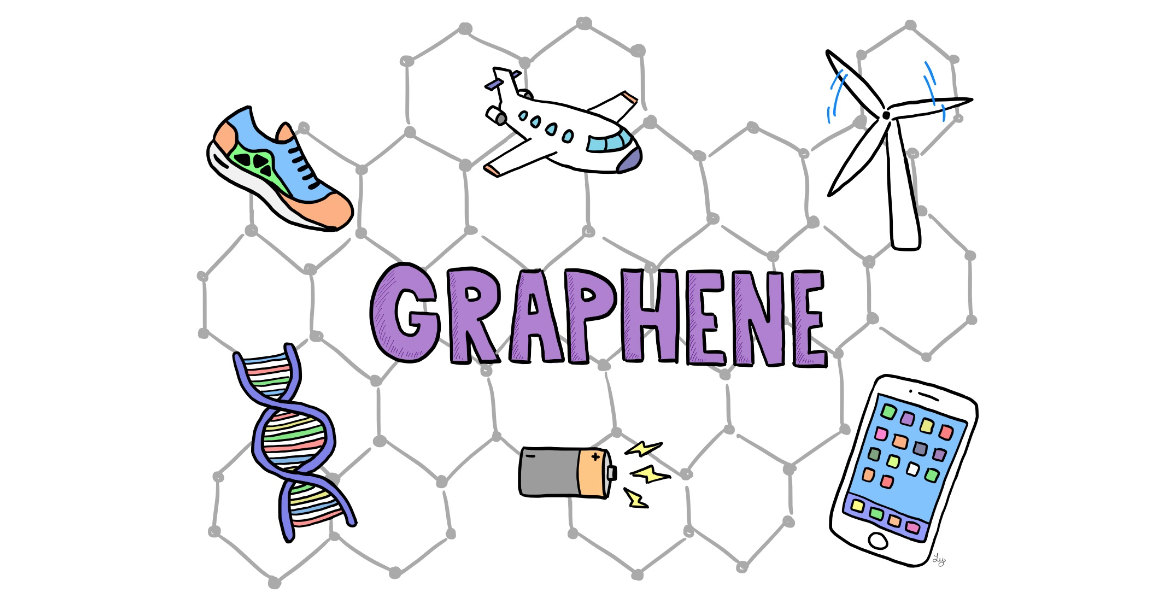Imagine a future where cell phones can be charged in seconds and tablets roll up like newspapers. As scientists delve deeper into the field of nanoscience, developments like these appear more possible than ever.
Nanoscience is the study of matter at the nanoscopic level, or nanoscale. Consequently, scientists and engineers can study nanomaterials, such as nanotubes and nanogold, at the molecular level to reveal their unique properties.
One such material is graphene, which is often referred to as a “wonder material.” Discovered by researchers at the University of Manchester in 2004, graphene is a single layer of graphite, which makes up materials such as pencil lead. Graphene is an allotrope, or form of the element carbon. The carbon atoms are arranged in a hexagonal, honeycomb-like structure, giving rise to important properties such as thermal conductivity, elasticity, and chemical inertness.
Due to its unique physical and chemical properties, graphene demonstrates fascinating traits. It is the lightest, thinnest, and strongest carbon allotrope and was the first human-made two-dimensional material to be isolated. Despite being one atom thick, it is 200 times stronger than steel and is the lightest, most conductive human-made material on Earth. It thus has the potential to be applied to many different fields, although it is still in the early stages of development.
“As with any new technology, it takes time to commercialize a product, and not many [graphene products] are on the market yet,” Raed Abdo, a Master’s student in Electrical Engineering, wrote in an email to The McGill Tribune. “However, we can expect to see it soon in different applications, including battery sensors, coatings, and construction.”
Indeed, graphene has numerous applications. For example, scientists at the University of Manchester have created a graphene coating that could protect cars and ships from rust. Graphene’s thinness and sensitivity to chemicals has led to the design of graphene membranes to purify water, keep food fresh for longer, and identify harmful substances in the agricultural industry, which allows farmers to protect crops accordingly. Additionally, because it is capable of filtering out nuclear waste and salt, graphene could provide clean drinking water to millions of people in developing countries.
Water quality monitoring is an extremely important application of graphene, and one that is being pursued by McGill researchers. Along with PhD candidate Ibrahim Fakih and Professor Thomas Szkopek, Abdo recently launched UltraSense, a start-up that uses low-cost, high-resolution chemical sensors composed of graphene to monitor water quality.
Furthermore, graphene’s high flexibility and strength make it an ideal candidate for use in implant and tissue engineering technology, as it can withstand and adapt to biological forces. It can even be programmed to target specific tissue, such as cancer cells, to effectively deliver drugs. Graphene has also been used in running shoes, since it is more resistant to wear and tear. At McGill, Szkopek’s lab has designed graphene-based headphones that showcase exemplary sound quality.
However, despite graphene’s benefits, Abdo noted that there are some challenges.
“Graphene is just a single layer of carbon atoms, so it is a challenge to make large-scale devices without degrading the quality of the graphene,” Abdo said.
Other difficulties include biological compatibility, toxicity, and stability, as well as the financial challenges associated with obtaining large amounts of graphene, which is not currently produced at an industrial scale. Though there is promising new research on sustainably producing graphene with bacteria, Abdo warns against over-reliance on the material.
“While graphene is indeed a unique material, we should not force it into our daily lives just for the sake of it,” Abdo said. “We can use it in applications that improve existing technologies, and that takes time.”










I visited with Ibrahim Fakih, in his lab last winter. I must say their sensor work is world class and cutting edge. Being a hard core Graphene nerd I think the last sentence speaks volumes. Again, I would like to thank the folks over at McGill for taking the time for a fan boy.
Yeah, graphene can be used in a lot of applications and can be a huge technology in the coming days, but I think it has a significant amount of drawbacks that should be fixed first.